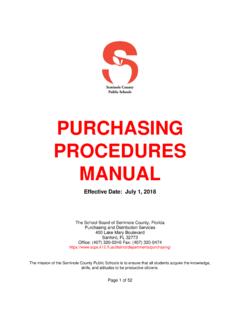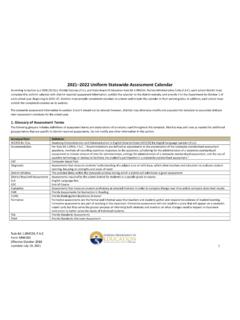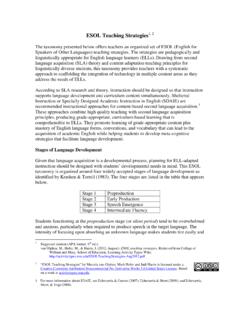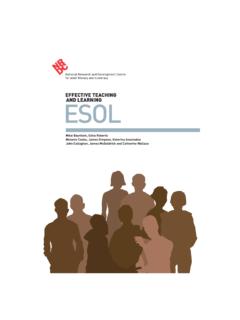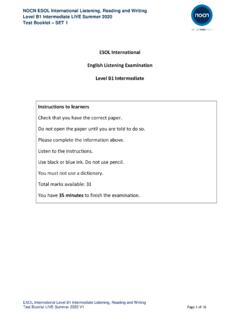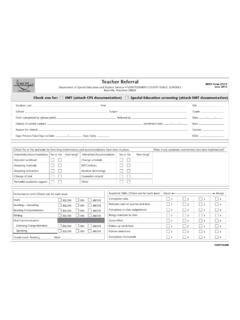Transcription of THE FLORIDA CONSENT DECREE: A SUMMARY
1 THE FLORIDA CONSENT decree : A SUMMARY BACKGROUND In August, 1990, a judge of the United States District Court, Southern District of FLORIDA , signed a CONSENT decree giving the court power to enforce an agreement between the FLORIDA State Board of Education and a coalition of eight groups represented by Multicultural Education, Training, and Advocacy, Inc. (META) and FLORIDA legal services attorneys regarding the identification and provision of services to students to whose native language is other than English. The plaintiff organizations involved in the case represent a broad spectrum of the civil rights/educational community. They are: League of United Latin American Citizens (LULAC) ASPIRA of FLORIDA The Farmworkers Association of Central FLORIDA FLORIDA State Conference of NAACP Branches Haitian Refugee Center Spanish American League Against Discrimination (SALAD) American Hispanic Educators Association of Dade (AHEAD) Haitian Educators Association The CONSENT decree settlement terms focus on the following six issues: I.
2 Identification and Assessment II. Equal Access to Appropriate Programming III. Equal Access to Appropriate Categorical and Other Programming for English Limited Learner (ELL) students IV. Personnel V. Monitoring VI. Outcome Measures Section I, Identification and Assessment Addresses six requirements: 1. Home language survey. The home language survey and national origin data of all students must be collected and retained in the school district. The home language survey may be included on the registration form or on a separate survey and must be administrated to all students. The survey includes the following questions: a. Is a language other than English used in the home? b. Does the student have a first language other than English? c. Does the student most frequently speak a language other than English? 2. ELL Committee. The ELL Committee, a team comprised of ESOL teacher (s), home language teacher (if any), administrator (or designee), parent(s), plus guidance counselor, social worker, school psychologist, or other educator(s) and is responsible for determining the eligibility of a student for an ESOL program.
3 3. ELL Student Plan. The ELL student plan is a written document which identifies student name, instruction by program, including programs other than ESOL, amount of instructional time or schedule, date of ELL identification, and assessment data used to classify or reclassify as ELL, etc. Each student must have an individual copy of the plan maintained in his/her file. 4. English Language Assessment. Language assessment is required in the areas of listening comprehension, speaking, reading, and writing. Each student will also be assessed in the basic subjects areas ( computer literacy, math, science, and social studies). 5. Classification and Reclassification. Students classified as ELL continue to receive appropriate instruction until such time as the student is reclassified as English proficient, or otherwise exited from the ESOL program by the ELL committee. Special weighted funding may extend up to six years; however, lack of ESOL funding does not relieve the school system of the obligation to provide such services.
4 6. Post-reclassification Monitoring. The performance of students who have been exited from the ESOL program must be reviewed to identify any patterns of continuing under performance on appropriate test and/or grades. Such review occurs at the time of the student's first report card, semiannually during the first after exiting, and the end of the second year. Exemptions provided to ELL students: Students in grades 4 and 7, who have been in the program for two or fewer years may be exempted from participation in statewide assessment. School districts shall offer alternatives for measurement of minimum standards in these grades. Secondary students who failed to meet the 10th grade standards as measured by the FCAT, shall be provided compensatory education for a "thirteenth" year of high school. Section II, Equal access to Appropriate Programming The primary goal of all such programming is to develop as effectively and efficiently as possible each child's English language proficiency and academic potential.
5 Such programs should also provide positive reinforcement of the self-image and esteem of participating students, promote cross-cultural understanding, and provide equal educational opportunities. Equal access appropriate programming must include both access to intensive English language instruction and instruction in basic subject matter areas of math, science, social studies, computer literacy which is: 1. Understandable to the ELL student giving his/her level of English language proficiency, and 2. Equal and comparable in amount, scope, sequence, and quality to that provided English proficient students. Recommendations for such programming shall be documented in the form of a ELL student plan, which shall be in conformity with this agreement. Equal access to appropriate programming includes five requirements: 1. District ELL Plan: School districts are required to submit a multi-year ELL plan, to be updated and resubmitted every three years.
6 Interim changes are submitted for approval as amendments. The district ELL plan includes: Standards for entry, exit, and post-reclassification monitoring, Instructional, categorical, and student services Provisions for and plans to employ qualified staff, and Evidence of consultation with parent council or advisor body. 2. Basic ESOL instruction. Basic ESOL includes instruction in speaking, listening, reading, and writing English in an instructional program appropriate to the proficiency level and academic potential of the students. 3. ESOL instruction, and home language instructional strategies in basic subject areas. Districts are required to provide appropriate home language instruction (Curriculum content in the home language/bilingual curriculum content) or ESOL content instruction (Curriculum content in English using ESOL strategies), or a combination of the two, in science, social studies, mathematics, and computer literacy.
7 4. Identification of interim staffing, and in-service measures. In the recognition that districts may not have appropriately trained personal to deliver basic ESOL instruction and understandable instruction in basic subject areas, the District ELL Plan must include interim measures which report the number of students not appropriately served, documentation of recruitment and training, a time-line for meeting staffing needs, and a plan for interim measures which must include in-service training, utilization of native language aides and materials to assure that the students are learning. 5. Parental involvement. Parental involvement and participation in ELL students' educational programming and academic achievement is required by formation of parent groups consisting of a majority of parents of ELL students. Such groups must be consulted prior to submission of the District ELL Plan to the state. Parents must be provided appropriate training by the school district.
8 Section III, Equal access to appropriate categorical and other programs for ELL students Provides overall equal access requirements, such as a prohibition of denial of service because of a student's level of English proficiency, and a student's right to access whether the program is offered before, during, or after the regular school day. Section III also includes special requirements with respect to ten categoricals and other programs/services for ELL students: 1. Compensatory education. Requirements under this section include both Chapter 1 basic and/or migrant education, as well as compensatory programming. Equal access is required for ELL students, as well as understandable instruction in a manner appropriate to the students' level of English proficiency. For Chapter 1 and state compensatory programming, an annual report is required providing the number of students served, and services by race, national origin, and limited English proficiency.
9 2. Exceptional student education. Requirements under this section apply both to handicapped and gifted students, and repeat equal access requirements previously given for regular education of ELL students. Data are reported annually on the number of exceptional students served by race, national origin, limited English proficiency, and type of exceptional program. All requirements under section I and II are applicable to exceptional students education. 3. Dropout prevention. Three requirements are given for dropout prevention programs and services: (a) equal access for ELL students, (b) annual report of the number of students served by dropout prevention programs by race, national origin, limited English proficiency, and type of service, and (c) ELL parent participation in the development of the district's comprehensive program plan for dropout prevention. ELL parent participation in the development of the comprehensive plan is a new dimension to this program.
10 4. Student services. Equal access to students services ( counseling) is required for ELL students, pursuant to ( FLORIDA Statute) Section 5. Pre-kindergarten programs. Equal access to pre-kindergarten programs is required for ELL students, including programs such as Head Start, Migrant Pre-Kindergarten, Pre-Kindergarten Early Intervention, and related programs. Required also is annual reporting of the number of ELL, racial and national origin minority children eligible for and served by pre-kindergarten programs, indicating which programs they are served by. In order to meet these requirements, it is necessary to test all pre-K participants for English proficiency and pre-K ELL students must be provided the services by the CONSENT decree . 6. Equal access for immigrant students. Free, equal, and unhindered access to appropriate schooling is required for all immigrant students in compliance with a 1982 Supreme Court ruling (Plyler vs.)


